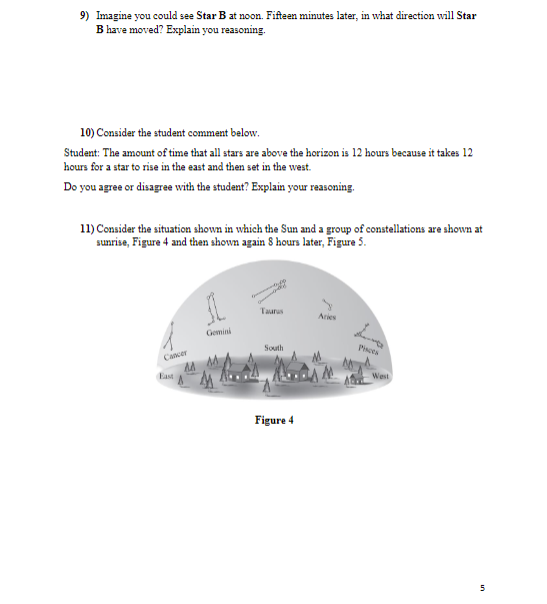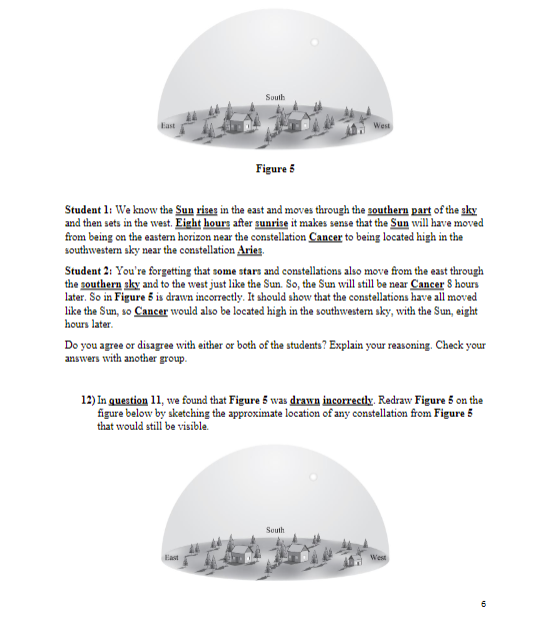Student 1: We know the Sun rises in the east and moves through the southern part of the sky and then sets in the west. Eight hours after sunrise it makes sense that the Sun will have moved from being on the eastern horizon near the constellation Cancer to being located high in the southwestern sky near the constellation Aries. Student 2: You're forgetting that some stars and constellations also move from the east through the southern sky and to the west just like the Sun. So, the Sun will still be near Cancer 8 hours later. So in Figure 5 is drawn incorrectly. It should show that the constellations have all moved like the Sun, so Cancer would also be located high in the southwestern sky, with the Sun, eight hours later. Do you agree or disagree with either or both of the students? Explain your reasoning. Check your answers with another group. 12) In question 11, we found that Figure 5 was drawn incorrectly. Redraw Figure 5 on the figure below by sketching the approximate location of any constellation from Figure 5 that would still be visible. South East West
Student 1: We know the Sun rises in the east and moves through the southern part of the sky and then sets in the west. Eight hours after sunrise it makes sense that the Sun will have moved from being on the eastern horizon near the constellation Cancer to being located high in the southwestern sky near the constellation Aries. Student 2: You're forgetting that some stars and constellations also move from the east through the southern sky and to the west just like the Sun. So, the Sun will still be near Cancer 8 hours later. So in Figure 5 is drawn incorrectly. It should show that the constellations have all moved like the Sun, so Cancer would also be located high in the southwestern sky, with the Sun, eight hours later. Do you agree or disagree with either or both of the students? Explain your reasoning. Check your answers with another group. 12) In question 11, we found that Figure 5 was drawn incorrectly. Redraw Figure 5 on the figure below by sketching the approximate location of any constellation from Figure 5 that would still be visible. South East West
Astronomy
1st Edition
ISBN:9781938168284
Author:Andrew Fraknoi; David Morrison; Sidney C. Wolff
Publisher:Andrew Fraknoi; David Morrison; Sidney C. Wolff
Chapter6: Astronomical Instruments
Section: Chapter Questions
Problem 26E: Approximately 9000 stars are visible to the naked eye in the whole sky (imagine that you could see...
Related questions
Question
100%
Please answer all questions on page 6. There is an agree or disagree question and there's a #12 question as well. Please open the image to see page 6. Page 5 has background information.

Transcribed Image Text:9) Imagine you could see Star B at noon. Fifteen minutes later, in what direction will Star
B have moved? Explain you reasoning.
10) Consider the student comment below.
Student: The amount of time that all stars are above the horizon is 12 hours because it takes 12
hours for a star to rise in the east and then set in the west.
Do you agree or disagree with the student? Explain your reasoning.
11) Consider the situation shown in which the Sun and a group of constellations are shown at
sunrise, Figure 4 and then shown again 8 hours later, Figure 5.
1
Taurus
Aries
Gemini
South
Figure 4
Cancer
M
Pisces
MA
Ab West
5

Transcribed Image Text:South
East
West
Figure 5
Student 1: We know the Sun rises in the east and moves through the southern part of the sky
and then sets in the west. Eight hours after sunrise it makes sense that the Sun will have moved
from being on the eastern horizon near the constellation Cancer to being located high in the
southwestern sky near the constellation Aries.
Student 2: You're forgetting that some stars and constellations also move from the east through
the southern sky and to the west just like the Sun. So, the Sun will still be near Cancer 8 hours
later. So in Figure 5 is drawn incorrectly. It should show that the constellations have all moved
like the Sun, so Cancer would also be located high in the southwestern sky, with the Sun, eight
hours later.
Do you agree or disagree with either or both of the students? Explain your reasoning. Check your
answers with another group.
12) In question 11, we found that Figure 5 was drawn incorrectly. Redraw Figure 5 on the
figure below by sketching the approximate location of any constellation from Figure 5
that would still be visible.
South
East
West
Expert Solution
This question has been solved!
Explore an expertly crafted, step-by-step solution for a thorough understanding of key concepts.
This is a popular solution!
Trending now
This is a popular solution!
Step by step
Solved in 2 steps with 1 images

Knowledge Booster
Learn more about
Need a deep-dive on the concept behind this application? Look no further. Learn more about this topic, physics and related others by exploring similar questions and additional content below.Recommended textbooks for you

Astronomy
Physics
ISBN:
9781938168284
Author:
Andrew Fraknoi; David Morrison; Sidney C. Wolff
Publisher:
OpenStax


Stars and Galaxies
Physics
ISBN:
9781305120785
Author:
Michael A. Seeds, Dana Backman
Publisher:
Cengage Learning

Astronomy
Physics
ISBN:
9781938168284
Author:
Andrew Fraknoi; David Morrison; Sidney C. Wolff
Publisher:
OpenStax


Stars and Galaxies
Physics
ISBN:
9781305120785
Author:
Michael A. Seeds, Dana Backman
Publisher:
Cengage Learning

Foundations of Astronomy (MindTap Course List)
Physics
ISBN:
9781337399920
Author:
Michael A. Seeds, Dana Backman
Publisher:
Cengage Learning


Stars and Galaxies (MindTap Course List)
Physics
ISBN:
9781337399944
Author:
Michael A. Seeds
Publisher:
Cengage Learning